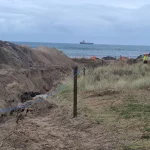Mobile Operators Shun Plan to Expand 4G on Tyne and Wear Metro UPDATE

The Tyne and Wear Metro, which is an overground and underground light rail rapid transit system that is operated by Nexus (public body), looks unlikely to see 4G and 5G mobile coverage being expanded from O2 (Virgin Media), Vodafone and Three UK after the operators “turned down the opportunity to install equipment in the tunnels.”
The transit system, which has had some 4G (mobile broadband) coverage from EE (BT) in the tunnels since 2019, currently serves Newcastle upon Tyne, Gateshead, North Tyneside, South Tyneside, and the City of Sunderland – together forming the ceremonial county of Tyne and Wear in North East England.
However, back in February 2023 a plan was hatched by Nexus, which sought to “improve digital connectivity on Tyne and Wear Metro, with the aim of creating a seamless 4G or 5G signal across the whole network” (here). Nexus essentially intended to engage with O2, Three UK and Vodafone to build improved connectivity in those ‘not spot’ areas where the signal is weaker, including tunnels, cuttings and lines near the coast.
Advertisement
The approach was seen as being cheaper and easier to deploy than delivering on-train WiFi, which was also found to be less popular among commuters than directly improving mobile coverage. Nexus originally planned to do this upgrade earlier, but that effort was “held up during the Covid-19 pandemic“.
What went wrong for Nexus?
The problem is that a year and a half has now passed since the plan was re-started and nothing much appears to have happened. Nexus has not issued any further updates, although we have now managed to get a response from the organisation (see update at the bottom).
Thankfully one of our readers, Scott, who is a local resident of the area, did – after making several attempts over several weeks – finally elicit a brief response from Nexus: “Unfortunately other telephone suppliers turned down the opportunity to install equipment in the tunnels.”
As for the mobile network operators themselves: O2 (Virgin Media) declined to comment, while Three UK completely ignored several of our hails, and a spokesperson for Vodafone offered somewhat of an olive branch: “We did have early conversations with Nexus regarding the programme. We’d be happy to discuss it further with them.”
Advertisement
However, ISPreview understands from our research that EE may have had an advantage over the other operators, due in part to the historical way the system was deployed (i.e. they appear to have inherited the fibre used for backhaul in the tunnels). Rival operators would thus have needed to deliver their own cables to every signal station, which is an incredibly costly and logistical challenge given that it involves working around a live railway.
The London Underground and Tfl solved a similar problem by adopting neutral host services via Boldyn Networks (i.e. a network that all operators could access on the same terms), although making the case for such a big project on the Tyne and Wear Metro would still have been quite challenging.
Suffice to say that it doesn’t look like mobile connectivity for non-EE based operators on the Metro is going to get better anytime soon, which is somewhat of a missed opportunity given all of the recent investment that has gone into the Metro (e.g. the £362m programme to build a new fleet of trains, which recently reached the halfway stage with 23 of 46 new Stadler trains now built).
UPDATE 17th July 2024 @ 11:37am
Advertisement
We’ve had a response from Nexus, which offers a glimmer of hope.
Huw Lewis, Customer Services Director at Nexus, told ISPreview:
“We remain fully committed to delivering improved mobile phone connectivity for our customers on the Tyne and Wear Metro.
This includes the tunnels through city centres, and where Metro runs close to the coast, where there are fewer surrounding masts.
Connectivity varies between phone companies and we want our customers to be able to access a range of networks. Anyone on the EE network will have connectivity when they are in our underground stations.
Our customers see strong connectivity on trains across most of the system, but there are a number of small stretches where it could be better.
We have engaged a specialist consultant to advise on the project and engage with more major network providers.
We’re confident that we can deliver an improvement in mobile connectivity on Metro at the completion of this project.”
Mark is a professional technology writer, IT consultant and computer engineer from Dorset (England), he also founded ISPreview in 1999 and enjoys analysing the latest telecoms and broadband developments. Find me on X (Twitter), Mastodon, Facebook, BlueSky, Threads.net and Linkedin.
« Welsh Government Sees Opportunity to Review Gigabit Broadband Plan























































Not surprised about this. The ineptitude of Nexus is notorious in the North East.
23 of 46 trains delivered, yet not a single one in operation yet.
The TfL/Boldyn agreement for the underground has been described by Boldyn as involving investment of £1bn over the twenty year contract and operating costs of perhaps a further £1.1bn, and for that it covers around 400km of tunnel pairs and 137 stations, and in addition to the tunnels uses over 80,000 small cells.
Given that the Tyne & Wear Metro has what, nine underground stations, underground tunnels of say 12 miles (total system is only 48 miles), I’d have thought that if done at a similar unit cost, it would be around £70-100m up front and the same sort of operating costs over twenty years, including fixing a fair number of notspots on the overground sections.
Whether there’s any business case, or public interest benefit to support that I can’t say. With 37 million passengers a year, my guesstimated figures imply an incremental cost per journey of 27p.
I’m not an expert but I suspect fixing the overground sections is harder due to the risk of any new cell causing interference with other existing cells. This risk is massively reduced when underground 🙂
As a resident of the area and Vodafone user it would be nice to have a steady 4g service, let alone 5g. I would think it’s impossible to prove but it feels that coverage is much worse since 3G has begun being switched off. So much was made of the possibility of 5g, but unless you’re in a large city it seems unlikely that you’ll ever see it particularly the high frequency bands and therefore high speeds.
Exactly the same issue on HS1, the operator went to EE and then EE tried to gouge the other MNOs.
EE is a monopoly provider and should be treated as such. Their coverage though, is still TERRIBLE indoors.
I suspect Nexus are looking for a major contribution or revenue share from the mobile operators. In reality due to inclusive minutes/text/bundled data tariffs there will be little revenue increase for the operators and they may not even recover their costs.
This assumes that customers aren’t willing to move to EE in order to use the network… And if they’re not, then perhaps it shows that customers don’t _really_ want mobile coverage?
Very closed minded, Ben. I find myself stuck on EE so I can use it the check timetables/disruptions/live times underground – yet the EE signal is non-existent at home and 50/50 at work; I have to use WiFi calling.
Thanks for the article Mark. One of the points here is that you get zero signal in the underground stations (Monument, Central, Haynarket etc) unless you’re on EE and Nexus often tell you to check the Pop App for latest times on the departure boards. See what the problem here is? That, and the fact the reason they gave to shelve the on-board wifi doesn’t stand if there is no or little coverage.
Well, at least that spares fellow homeward-bound travellers having to listen to some 18-30 Geordy shouting into the phone telling his significant other that he’s just passed station X and is 15 minutes away from home and to take the cork out of the Kanga brand Chardonnay and get the pan-fired trout on the gas. Not that that conversation would take place t-up there, anyway.(Sic Andy Hamilton)
Over-head catenary, metal rails and track-side wiring and nobody using 2G smart meters in the vicinity Looks like the alternative means of signal transmission are pretty limited then.